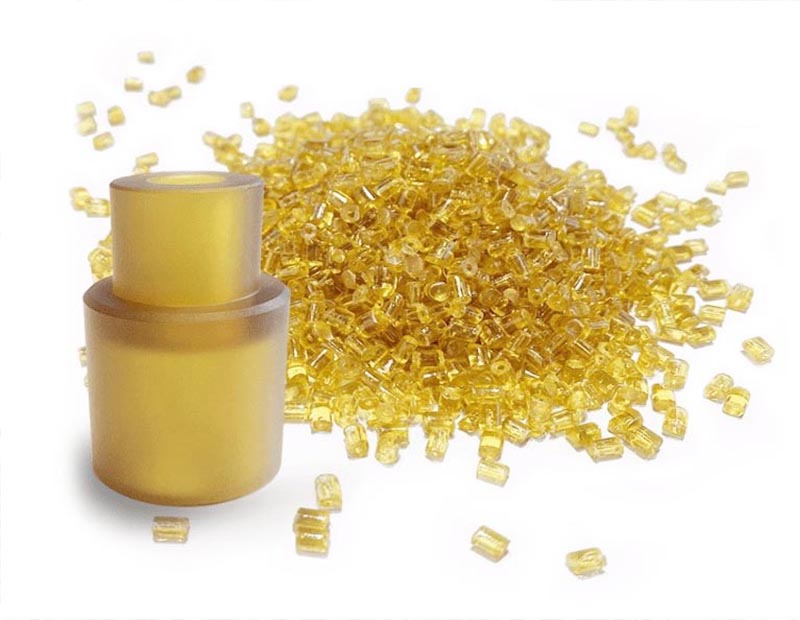PEI Resin: Properties, Applications, and Maintenance
Introduction to PEI Resin
Polyetherimide (PEI) resin is an amorphous, High-performance thermoplastic known for its exceptional thermal stability, mechanical strength, and chemical resistance. Developed by General Electric (now SABIC) under the trade name Ultem®, PEI resin combines the processability of thermoplastics with the performance characteristics typically associated with high-temperature thermosets. With a glass transition temperature (Tg) of 217°C and continuous use temperature up to 170°C, PEI maintains dimensional stability under extreme conditions.

Key Characteristics of PEI Resin
1. Thermal Properties
PEI resin exhibits outstanding thermal stability with a heat deflection temperature (HDT) of 200°C at 1.82 MPa and 210°C at 0.45 MPa. Its UL 94 flammability rating is V-0 at thicknesses as low as 0.25 mm, with a limiting oxygen index (LOI) of 47%, making it inherently flame-retardant without additives. The coefficient of thermal expansion ranges from 3.1-5.6 × 10⁻⁵/°C, ensuring minimal dimensional changes across temperature fluctuations.
2. Mechanical Performance
With a tensile strength of 105-110 MPa and flexural strength of 145-165 MPa, PEI demonstrates robust mechanical properties. Its modulus of elasticity measures 3.0-3.3 GPa, while elongation at break reaches 60-80%, indicating good toughness. The material maintains 85% of its room temperature tensile strength at 150°C, outperforming most engineering thermoplastics at elevated temperatures.
3. Chemical Resistance
PEI resin shows excellent resistance to hydrocarbons, alcohols, and halogenated solvents, with less than 1% weight gain after 24-hour immersion in most organic solvents. It withstands prolonged exposure to 10% sulfuric acid and 20% sodium hydroxide solutions at 60°C with minimal property degradation. However, it is susceptible to strong bases (pH >12) and polar solvents like acetone and methylene chloride.
4. Electrical Properties
The dielectric strength of PEI measures 33 kV/mm, with a dielectric constant of 3.15 at 1 MHz and dissipation factor of 0.0013 at 1 MHz. These stable electrical characteristics across a frequency range of 50 Hz to 1 GHz and temperatures up to 200°C make it ideal for high-frequency applications.
5. Optical Characteristics
Natural PEI resin exhibits 50-60% light transmission in the visible spectrum (400-700 nm) with a yellow index of 10-15. Its refractive index is 1.66, and it maintains optical clarity after repeated sterilization cycles, making it suitable for medical applications.
Comparative Properties Table
| Property | PEI | PEEK | Polycarbonate |
|---|---|---|---|
| Tensile Strength (MPa) | 105-110 | 90-100 | 55-75 |
| HDT @ 1.82 MPa (°C) | 200 | 160 | 140 |
| Dielectric Constant (1 MHz) | 3.15 | 3.2 | 2.9 |
| Flammability Rating | V-0 | V-0 | HB |
Applications of PEI Resin
1. Aerospace Components
PEI resin is extensively used in aircraft interiors, including seat components, tray tables, and overhead bins, where its FST (Fire, Smoke, Toxicity) compliance meets FAA regulations. Its specific gravity of 1.27 g/cm³ provides significant weight savings over metals, reducing fuel consumption by 15-20% in replaced components.
2. Medical Devices
The material's autoclavability (1000+ cycles at 134°C) and gamma radiation resistance (50 kGy) make it ideal for surgical instruments, sterilization trays, and imaging equipment components. PEI's USP Class VI and ISO 10993 biocompatibility certifications enable direct tissue contact applications.
3. Electrical and Electronics
In electronics, PEI serves as a high-performance alternative to polyimides in connectors, sockets, and circuit boards. Its CTI (Comparative Tracking Index) of 600V and arc resistance of 128 seconds meet stringent requirements for miniature components in high-voltage environments.
4. Automotive Systems
Under-the-hood applications utilize PEI for sensor housings, throttle bodies, and transmission components where temperatures exceed 150°C. Its UL 746C RTI rating of 170°C for electrical properties ensures reliable performance in electric vehicle battery systems.
5. Industrial Equipment
PEI's resistance to 5000 hours of UV exposure and hydrolysis makes it suitable for pump components, valve seats, and semiconductor manufacturing equipment. Its PV limit of 3.5 MPa·m/s enables use in demanding tribological applications.
Maintenance and Care Guidelines
1. Cleaning Procedures
For routine cleaning, use mild detergent solutions (pH 5-9) at temperatures below 80°C. Avoid abrasive cleaners that may scratch the surface (Ra >0.8 μm). For sterilization, autoclave at 121-134°C for 15-30 minutes or use ethylene oxide gas treatment.
2. Storage Conditions
Store PEI components in 20-30°C environments with <50% RH to prevent moisture absorption (>0.25% w/w). Use desiccant packages when storing for extended periods (>6 months). Avoid direct sunlight exposure to prevent slight yellowing (ΔYI <5 after 1000 hours UV).
3. Machined Part Maintenance
For machined PEI parts, periodically check dimensional stability (±0.05 mm over 100 mm). Relubricate bearing surfaces every 500 operating hours using PFPE-based lubricants. Inspect for stress cracking (especially in 3D-printed parts) using magnified inspection or dye penetrant methods.
4. Joining and Repair
Ultrasonic welding requires 20-40 kHz frequency at 0.5-1.5 MPa pressure. For adhesive bonding, use epoxy or cyanoacrylate formulations with surface treatment (plasma or chemical etching to achieve >50 dynes/cm surface energy). Anneal stress-relieved parts at 160-180°C for 1-4 hours depending on wall thickness.
5. End-of-Life Considerations
PEI resin is recyclable through mechanical recycling (up to 5 regrind cycles with <15% property loss). For incineration, its high calorific value (32 MJ/kg) enables energy recovery. Chemical recycling via hydrolysis at 200-250°C can recover monomeric components.






